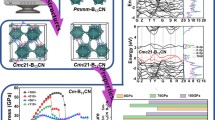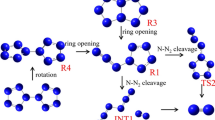Abstract
One of the most important aims in the development of high-energy materials is to improve their stability and thus ensure that they are safe to manufacture and transport. In this work, we theoretically investigated open-chain N4B2 isomers using density functional theory in order to find the best way of stabilizing nitrogen-rich molecules. The results show that the boron atoms in these isomers are aligned linearly with their neighboring atoms, which facilitates close packing in the crystals of these materials. Upon comparing the energies of nine N4B2 isomers, we found that the structure with alternating N and B atoms had the lowest energy. Structures with more than one nitrogen atom between two boron atoms had higher energies. The energy of N4B2 increases by about 50 kcal/mol each time it is rearranged to include an extra nitrogen atom between the two boron atoms. More importantly, our results also show that boron atoms stabilize nitrogen-rich molecules more efficiently than carbon atoms do. Also, the combustion of any isomer of N4B2 releases more heat than the corresponding isomer of N4C2 does under well-oxygenated conditions. Our study suggests that the three most stable N4B2 isomers (BN13, BN24, and BN34) are good candidates for high-energy molecules, and it outlines a new strategy for designing stable boron-containing high-energy materials.

The structural characteristics, thermodynamic stabilities, and exothermic properties of nitrogen-rich N4B2 isomers were investigated by means of density functional theory







Similar content being viewed by others
References
Jasper S, Hammond A, Thomas J, Kidd L, Strout DL (2011) N22C2 versus N24: role of molecular curvature in determining isomer stability. J Phys Chem A 115(42):11915–11918. doi:10.1021/jp208280c
Shi LW, Wu WM, Zhao G, Chen MB (2010) From tortoise-shell-like molecular segments to C4n H2n N2n (n = 3–8) cages stabilized by alkenyl: a theoretical study. J Phys Chem A 114(10):3691–3697. doi:10.1021/jp911788p
Liang YH, Luo Q, Guo M, Li QS (2012) What are the roles of N3 and N5 rings in designing polynitrogen molecules? Dalton Trans 41(39):12075–12081. doi:10.1039/c2dt31016c
Valadbeigi Y (2016) Phosphorus-doped nitrogen clusters (NnPm): stable high energy density materials. Chem Phys Lett 645:195–199. doi:10.1016/j.cplett.2016.01.007
Tian A, Ding F, Zhang L, Xie Y, Schaefer HF (1997) New isomers of N8 without double bonds. J Phys Chem A 101(10):1946–1950. doi:10.1021/jp962878b
Fau S, Bartlett RJ (2001) Possible products of the end-on addition of N3 − to N5 + and their stability. J Phys Chem A 105(16):4096–4106. doi:10.1021/jp003970h
Qi C, Zhang R-B, Pang S-P (2013) Thermal stability of the N10 compound with extended nitrogen chain. RSC Adv 3(39):17741–17748. doi:10.1039/c3ra42439a
Li QS, Zhao JF (2002) Theoretical study of potential energy surfaces for N12 clusters. J Phys Chem A 106(21):5367–5372. doi:10.1021/jp020110n
Li QS, Liu YD (2002) Structures and stability of N11 cluster. Chem Phys Lett 353(3–4):204–212. doi:10.1016/s0009-2614(02)00018-0
Thompson MD, Bledson TM, Strout DL (2002) Dissociation barriers for odd-numbered acyclic nitrogen molecules N9 and N11. J Phys Chem A 106(29):6880–6882. doi:10.1021/jp0208182
Strout DL (2002) Acyclic N10 fails as a high energy density material. J Phys Chem A 106(5):816–818. doi:10.1021/jp0132073
Knapp C, Passmore J (2004) On the way to “solid nitrogen” at normal temperature and pressure? Binary azides of heavier group 15 and 16 elements. Angew Chem Int Ed 43(37):4834–4836. doi:10.1002/anie.200401748
Haiges R, Schneider S, Schroer T, Christe KO (2004) High-energy-density materials: synthesis and characterization of N5 +[P(N3)6]−, N5 + [B(N3)4]−, N5 + [HF2]−-n HF, N5 + [BF4]−, N5 + [PF6]−, and N5 + [SO3F]−. Angew Chem Int Ed 43(37):4919–4924. doi:10.1002/anie.200454242
Christe KO, Wilson WW, Sheehy JA, Boatz JA (2001) N5 +: a novel homoleptic polynitrogen ion as a high energy density material. Angew Chem Int Ed 40(16):2947–2947. doi:10.1002/1521-3773(20010817)40:16<2947::aid-anie11112947>3.0.co;2-c
Vij A, Pavlovich JG, Wilson WW, Vij V, Christe KO (2002) Experimental detection of the pentaazacyclopentadienide (pentazolate) anion, cyclo-N5 −. Angew Chem Int Ed 41(16):3051–3054. doi:10.1002/1521-3773(20020816)41:16<3051::AID-ANIE3051>3.0.CO;2-T
Cacace F, Petris GD, Troiani A (2002) Experimental detection of tetranitrogen. Science 295(5554):480–481. doi:10.1126/science.1067681
Chung G, Schmidt MW, Gordon MS (2000) An ab initio study of potential energy surfaces for N8 isomers. J Phys Chem A 104(23):5647–5650. doi:10.1021/jp0004361
Huang Y, Zhang Y, Shreeve JM (2011) Nitrogen-rich salts based on energetic nitroaminodiazido[1,3,5]triazine and guanazine. Chem Eur J 17(5):1538–1546. doi:10.1002/chem.201002363
Christe KO, Haiges R, Wilson WW, Boatz JA (2010) Synthesis and properties of N7O+. Inorg Chem 49(3):1245–1251. doi:10.1021/ic9022213
Klapotke TM, Stierstorfer J (2009) The CN7 − anion. J Am Chem Soc 131(3):1122–1134. doi:10.1021/ja8077522
Pangavhane SD, Hebedova L, Alberti M, Havel J (2011) Laser ablation synthesis of new phosphorus nitride clusters from α-P3N5 via laser desorption ionization and matrix assisted laser desorption ionization time-of-flight mass spectrometry. Rapid Commun Mass Spectrom 25(7):917–924. doi:10.1002/rcm.4937
Casey K, Thomas J, Fairman K, Strout DL (2008) Stability and dissociation energies of open-chain N4C2. J Chem Theory Comput 4(9):1423–1427. doi:10.1021/ct8001943
Abou-Rachid H, Hu A, Timoshevskii V, Song Y, Lussier LS (2008) Nanoscale high energetic materials: a polymeric nitrogen chain N8 confined inside a carbon nanotube. Phys Rev Lett 100(19):196401. doi:10.1103/PhysRevLett.100.196401
Sharma H, Garg I, Dharamvir K, Jindal VK (2010) Structure of polynitrogen clusters encapsulated in C60: a density functional study. J Phys Chem C 114(19):9153–9160. doi:10.1021/jp908755r
Zamani M, Keshavarz MH (2015) Thermochemical and detonation performance of boron-nitride analogues of organic azides and benzotrifuroxan as novel high energetic nitrogen-rich precursors. J Iran Chem Soc 12(6):1077–1087. doi:10.1007/s13738-014-0568-6
Liang Y, Li N (2014) Chain or ring: which one is favorable in nitrogen-rich molecules N6XH m , N8XH m , and N10XH m (X = B, Al, Ga, m = 1 and X = C, Si, Ge, m = 2)? J Phys Chem A 118(1):248–259. doi:10.1021/jp4094832
Nable RO, Bañuelos GS, Paull JG (1997) Boron toxicity. Plant Soil 193(1):181–198. doi:10.1023/a:1004272227886
Steinhauser G, Sterba JH, Foster M, Grass F, Bichler M (2008) Heavy metals from pyrotechnics in New Years Eve snow. Atmos Environ 42(37):8616–8622. doi:10.1016/j.atmosenv.2008.08.023
Croteau G, Dills R, Beaudreau M, Davis M (2010) Emission factors and exposures from ground-level pyrotechnics. Atmos Environ 44(27):3295–3303. doi:10.1016/j.atmosenv.2010.05.048
Lee C, Yang W, Parr RG (1988) Development of the Colle–Salvetti correlation-energy formula into a functional of the electron density. Phys Rev B 37(2):785–789. doi:10.1103/PhysRevB.37.785
Becke AD (1993) Density-functional thermochemistry. III. The role of exact exchange. J Chem Phys 98(7):5648–5652. doi:10.1063/1.464913
Dunning TH (1989) Gaussian basis sets for use in correlated molecular calculations. I. The atoms boron through neon and hydrogen. J Chem Phys 90(2):1007. doi:10.1063/1.456153
Purvis GD, Bartlett RJ (1982) A full coupled-cluster singles and doubles model: the inclusion of disconnected triples. J Chem Phys 76(4):1910–1918. doi:10.1063/1.443164
Scuseria GE, Janssen CL, Schaefer HF (1988) An efficient reformulation of the closed-shell coupled cluster single and double excitation (CCSD) equations. J Chem Phys 89(12):7382. doi:10.1063/1.455269
Frisch MJ, Trucks GW, Schlegel HB, Scuseria GE, Robb MA, Cheeseman JR, Scalmani G, Barone V, Mennucci B, Petersson GA, Nakatsuji H, Caricato M, Li X, Hratchian HP, Izmaylov AF, Bloino J, Zheng G, Sonnenberg JL, Hada M, Ehara M, Toyota K, Fukuda R, Hasegawa J, Ishida M, Nakajima T, Honda Y, Kitao O, Nakai H, Vreven T, Montgomery JA Jr, Peralta JE, Ogliaro F, Bearpark M, Heyd JJ, Brothers E, Kudin KN, Staroverov VN, Keith T, Kobayashi R, Normand J, Raghavachari K, Rendell A, Burant JC, Iyengar SS, Tomasi J, Cossi M, Rega N, Millam JM, Klene M, Knox JE, Cross JB, Bakken V, Adamo C, Jaramillo J, Gomperts R, Stratmann RE, Yazyev O, Austin AJ, Cammi R, Pomelli C, Ochterski JW, Martin RL, Morokuma K, Zakrzewski VG, Voth GA, Salvador P, Dannenberg JJ, Dapprich S, Daniels AD, Farkas O, Foresman JB, Ortiz JV, Cioslowski J, Fox DJ (2013) Gaussian 09, D.01. Gaussian, Inc., Wallingford
Bader RFW (1990) Atoms in molecules: a quantum theory. Oxford University Press, Oxford
Popelier P (2000) Atoms in molecules: an introduction. Prentice Hall, Manchester
Matta CF, Boyd RJ (2007) The quantum theory of atoms in molecules: from solid state to DNA and drug design. Wiley–VCH, Weinheim
Wu WJ, Zeng YL, Li XY, Zhang XY, Zheng SJ, Meng LP (2013) Interplay between halogen bonds and hydrogen bonds in OH/SH...HOX...HY (X = Cl, Br; Y = F, Cl, Br) complexes. J Mol Model 19(3):1069–1077. doi:10.1007/s00894-012-1657-z
Biegler-König F (2000) Aim 2000. University of Applied Science, Bielefeld
Montgomery JA, Frisch MJ, Ochterski JW, Petersson GA (1999) A complete basis set model chemistry. VI. Use of density functional geometries and frequencies. J Chem Phys 110(6):2822–2827. doi:10.1063/1.477924
NIST (2017) NIST Chemistry WebBook (online). webbook.nist.gov/chemistry/form-ser.html.
Zeng Y, Wu W, Li X, Zheng S, Meng L (2013) Influence of the Li···π interaction on the H/X···π interactions in HOLi···C6H6···HOX/XOH (X=F, Cl, Br, I) complexes. ChemPhysChem 14(8):1591–1600. doi:10.1002/cphc.201300075
Hobza P, Havlas Z (2000) Blue-shifting hydrogen bonds. Chem Rev 100(11):4253–4264. doi:10.1021/cr990050q
Politzer P, Murray JS, Clark T (2010) Halogen bonding: an electrostatically-driven highly directional noncovalent interaction. Phys Chem Chem Phys 12(28):7748–7757. doi:10.1039/c004189k
Blanksby SJ, Ellison GB (2003) Bond dissociation energies of organic molecules. Acc Chem Res 36(4):255–263. doi:10.1021/ar020230d
Acknowledgments
This work was supported by the National Natural Science Foundation of China (21473010).
Author information
Authors and Affiliations
Corresponding authors
Electronic supplementary material
ESM 1
(DOCX 20 kb)
Rights and permissions
About this article
Cite this article
Wu, WJ., Chi, WJ., Li, QS. et al. Strategy for designing stable and powerful nitrogen-rich high-energy materials by introducing boron atoms. J Mol Model 23, 191 (2017). https://doi.org/10.1007/s00894-017-3360-6
Received:
Accepted:
Published:
DOI: https://doi.org/10.1007/s00894-017-3360-6




